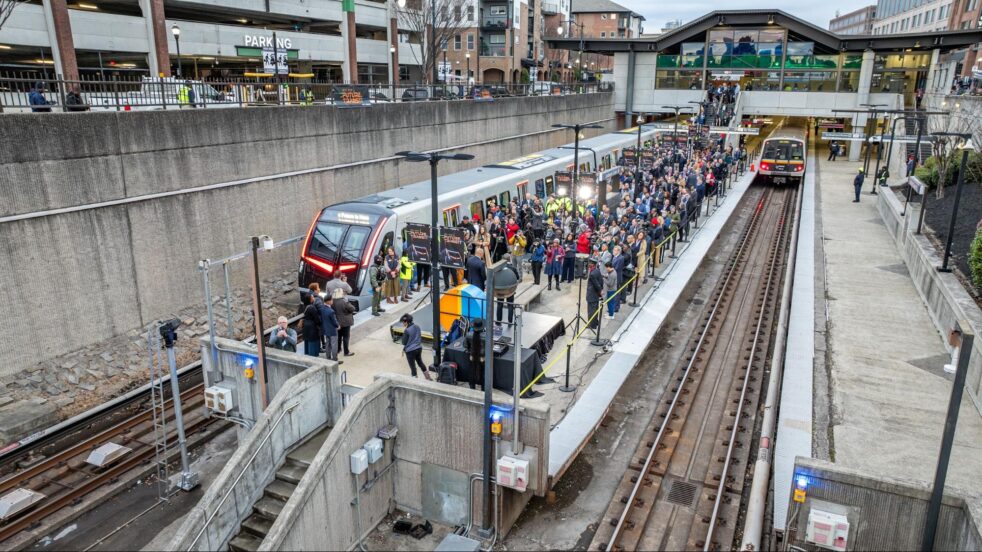On Jan. 30, Metro Atlanta Rapid Transit Authority (MARTA) officially unveiled its new, highly-anticipated CQ400 train during the annual State of MARTA event. The event, hosted by Collie Greenwood, MARTA General Manager and CEO, previewed the first-of-its-kind train in an announcement of one of the agency’s most significant system expansions and upgrades.
“When I stepped onto that new train this morning, it felt like stepping into the future,” Greenwood stated in a press release. “These new railcars are an inspiration to everyone at MARTA and to our customers who will get to experience a cleaner and safer ride.”
The new rail cars, set to roll out incrementally over the next four years, will completely replace MARTA’s current 35-40-year-old fleet.
Manufactured by Stadler Rail, MARTA will receive 56 CQ400 trains in total, each equipped with features considered to be the latest in current technology. Prefacing consumer comfort, passengers will be welcomed to upgraded seating, improved LED lighting, USB charging ports and digital displays that present real-time transit information, including upcoming stops, service alerts and route connections.
In response to rider safety concerns, MARTA has also enhanced current security measures. To ensure passenger safety, each railcar will be equipped with noise monitors and surveillance cameras that will be available conductors in case of emergencies.
“The goal was to create a seamless and comfortable experience for our riders,” said Connie Krisak, MARTA’s Senior Director of Vehicle Procurement, in an interview with the Technique. “We took extensive passenger feedback into account, ensuring that these trains meet the evolving needs of our commuters.”
In addition to enhanced passenger experiences, MARTA has placed a significant focus on improving upon current ridership services.
Referencing large-scale events scheduled for the Atlanta region, including the 2026 FIFA World Cup and Super Bowl LXII in 2028, along with a projected metro population growth of over two million in the next three decades, MARTA has designed its new system to accommodate both everyday riders and event-based surges in ridership.
The CQ400 series’ open gangway design, which allows uninterrupted movement between train cars, is just one example of this change that increases both passenger capacity and accessibility. Furthermore, a wider door design was added to decrease boarding times and station congestion during peak hours.
“These trains are built with the future in mind,” said Krisak. “We incorporated cutting-edge technology to ensure that the rail system remains a fast, reliable and modern transit option for Atlanta’s growing population.”
Besides improved passenger amenities and railway flow efficiencies, MARTA’s new rail cars have underscored a growing commitment to sustainability actions in the Atlanta area.
Other than the inherent nature of public transit reducing overall carbon footprint, MARTA’s sustainable strategies have been identified not only in its design — featuring regenerative braking and energy-efficient HVAC systems — but also in its method of retiring old train fleets.
In this, decommissioned train fleets can be seen reused as artificial barrier reefs off Georgia’s east coast or repurposed by developers into restaurants, markets and even interpretive art pieces.
“Sustainability, as always, started with small steps but has grown tremendously,” said Krisak. “Marta has really tried to step out in the forefront whenever we’re doing things such as renovating the stations and creating better places for Atlanta using materials that are either recycled or can be recycled.”
With major projects still underway, MARTA’s unveiling is just one of many steps officials are taking to create a cleaner, more efficient transportation system.
For Tech students, these advancements present a safer and more reliable commuting experience within the Atlanta metro. Whether that means heading to an internship, off-campus event or back home, the new MARTA system aims to redefine Atlanta public transit.
Citing those who are still hesitant about the transportation system, Krisak continues to encourage students, faculty and citizens to look past prior experiences or assumptions about the service and try it out for themselves.
“Allow your curiosity to lead you and to let you try the new wave of transportation design,” Krisak ended. “I think that it’s the design and all of the different amenities that MARTA has had in mind for the patrons that will really be worth it, so I would just say see for yourself how much better they will be.”
